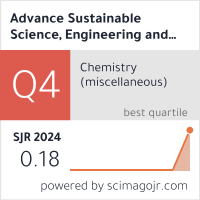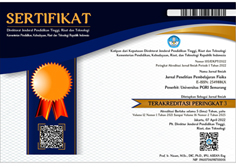Artificial Neural Network-Based Forecasting of Rice Yield Using Environmental and Agricultural Data
DOI:
https://doi.org/10.26877/asset.v7i3.2019Keywords:
Artificial Neural Network, Rice Yield Prediction, Agro-environmental, Climate-smart agriculture, Sustainable FarmingAbstract
This study presents a high-accuracy predictive model for rice production in Indonesia using Artificial Neural Networks (ANN), achieving an R² of 98.11%, Mean Absolute Error (MAE) of 0.0966, and Mean Squared Error (MSE) of 0.0189. Climate variability remains a significant challenge to rice cultivation in regions like Malang City, where unpredictable environmental factors such as rainfall, temperature, and humidity hinder effective crop planning and yield estimation. To address this, we developed a Multilayer Perceptron (MLP)-based ANN model incorporating agro-environmental variables: rainfall, temperature, humidity, harvested area, and production quantity. Historical data from 2009 to 2024 were sourced from the Meteorology, Climatology, and Geophysics Agency (BMKG) and the Central Statistics Agency (BPS). The dataset underwent preprocessing, including cleaning, feature extraction, Z-Score normalization, and partitioning into training and testing sets. The proposed ANN architecture consists of an input layer, three hidden layers, and an output layer for regression tasks. Comparative evaluation against Random Forest, K-Nearest Neighbors, and Support Vector Regression demonstrated the ANN’s superior ability to model complex nonlinear relationships in agricultural data. The results highlight the role of intelligent data-driven systems in enhancing the accuracy of yield forecasting, supporting sustainable agricultural practices, and informing national food security policy.
References
[1] S. Park, “World Bank,” in Essential Concepts of Global Environmental Governance, Second edition. | Abingdon, Oxon; New York: Routledge, 2021.: Routledge, 2020, pp. 289–290. doi: 10.4324/9780367816681-118.
[2] A. Dhamira and I. Irham, “THE IMPACT OF CLIMATIC FACTORS TOWARDS RICE PRODUCTION IN INDONESIA,” Agro Ekonomi, vol. 31, no. 1, Sep. 2020, doi: 10.22146/ae.55153.
[3] K. E. Ukhurebor et al., “Precision agriculture: Weather forecasting for future farming,” in AI, Edge and IoT-based Smart Agriculture, Elsevier, 2022, pp. 101–121. doi: 10.1016/B978-0-12-823694-9.00008-6.
[4] A. A. Mulema, L. Cramer, and S. Huyer, “Stakeholder engagement in gender and climate change policy processes: Lessons from the climate change, agriculture and food security research program,” Front Sustain Food Syst, vol. 6, Nov. 2022, doi: 10.3389/fsufs.2022.862654.
[5] S. Saud et al., “Comprehensive Impacts of Climate Change on Rice Production and Adaptive Strategies in China,” Front Microbiol, vol. 13, Jun. 2022, doi: 10.3389/fmicb.2022.926059.
[6] V. Sharma, A. K. Tripathi, and H. Mittal, “Technological revolutions in smart farming: Current trends, challenges & future directions,” Comput Electron Agric, vol. 201, p. 107217, Oct. 2022, doi: 10.1016/j.compag.2022.107217.
[7] P. Hara, M. Piekutowska, and G. Niedbała, “Selection of Independent Variables for Crop Yield Prediction Using Artificial Neural Network Models with Remote Sensing Data,” Land (Basel), vol. 10, no. 6, p. 609, Jun. 2021, doi: 10.3390/land10060609.
[8] D. Elavarasan and P. M. D. Vincent, “Crop Yield Prediction Using Deep Reinforcement Learning Model for Sustainable Agrarian Applications,” IEEE Access, vol. 8, pp. 86886–86901, 2020, doi: 10.1109/ACCESS.2020.2992480.
[9] M. G. M. Abdolrasol et al., “Artificial Neural Networks Based Optimization Techniques: A Review,” Electronics (Basel), vol. 10, no. 21, p. 2689, Nov. 2021, doi: 10.3390/electronics10212689.
[10] U. Bhimavarapu, G. Battineni, and N. Chintalapudi, “Improved Optimization Algorithm in LSTM to Predict Crop Yield,” Computers, vol. 12, no. 1, p. 10, Jan. 2023, doi: 10.3390/computers12010010.
[11] H. Crisóstomo de Castro Filho et al., “Rice Crop Detection Using LSTM, Bi-LSTM, and Machine Learning Models from Sentinel-1 Time Series,” Remote Sens (Basel), vol. 12, no. 16, p. 2655, Aug. 2020, doi: 10.3390/rs12162655.
[12] D. Elavarasan and P. M. D. Vincent, “Crop Yield Prediction Using Deep Reinforcement Learning Model for Sustainable Agrarian Applications,” IEEE Access, vol. 8, pp. 86886–86901, 2020, doi: 10.1109/ACCESS.2020.2992480.
[13] J. Patel, B. Vala, and M. Saiyad, “LSTM-RNN Combined Approach for Crop Yield Prediction On Climatic Constraints,” in 2021 5th International Conference on Computing Methodologies and Communication (ICCMC), IEEE, Apr. 2021, pp. 1477–1483. doi: 10.1109/ICCMC51019.2021.9418231.
[14] A. M. Alqudah and Z. Moussavi, “A Review of Deep Learning for Biomedical Signals: Current Applications, Advancements, Future Prospects, Interpretation, and Challenges,” Computers, Materials & Continua, vol. 83, no. 3, pp. 3753–3841, 2025, doi: 10.32604/cmc.2025.063643.
[15] I. Malashin, V. Tynchenko, A. Gantimurov, V. Nelyub, and A. Borodulin, “Applications of Long Short-Term Memory (LSTM) Networks in Polymeric Sciences: A Review,” Polymers (Basel), vol. 16, no. 18, p. 2607, Sep. 2024, doi: 10.3390/polym16182607.
[16] A. Satpathi et al., “Comparative Analysis of Statistical and Machine Learning Techniques for Rice Yield Forecasting for Chhattisgarh, India,” Sustainability, vol. 15, no. 3, p. 2786, Feb. 2023, doi: 10.3390/su15032786.
[17] P. Dhawas, A. Dhore, D. Bhagat, R. D. Pawar, A. Kukade, and K. Kalbande, “Big Data Preprocessing, Techniques, Integration, Transformation, Normalisation, Cleaning, Discretization, and Binning,” 2024, pp. 159–182. doi: 10.4018/979-8-3693-0413-6.ch006.
[18] J. Qi, J. Du, S. M. Siniscalchi, X. Ma, and C.-H. Lee, “On Mean Absolute Error for Deep Neural Network Based Vector-to-Vector Regression,” IEEE Signal Process Lett, vol. 27, pp. 1485–1489, 2020, doi: 10.1109/LSP.2020.3016837.
[19] D. Chicco, M. J. Warrens, and G. Jurman, “The coefficient of determination R-squared is more informative than SMAPE, MAE, MAPE, MSE and RMSE in regression analysis evaluation,” PeerJ Comput Sci, vol. 7, p. e623, Jul. 2021, doi: 10.7717/peerj-cs.623.
[20] D. S. K. Karunasingha, “Root mean square error or mean absolute error? Use their ratio as well,” Inf Sci (N Y), vol. 585, pp. 609–629, Mar. 2022, doi: 10.1016/j.ins.2021.11.036.











